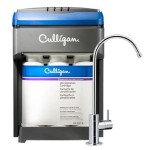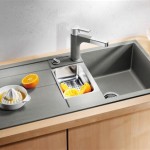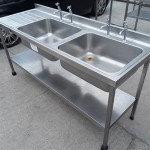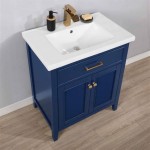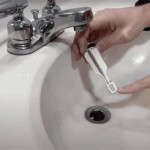Over The Sink Light Fixtures: Illuminating Your Kitchen Workspace
The area above the kitchen sink is a critical workspace, often used for food preparation, dishwashing, and general cleaning tasks. Adequate and appropriate lighting is essential to ensure safety, efficiency, and overall visual comfort in this high-use zone. Over-the-sink light fixtures provide focused illumination, mitigating shadows and enhancing visibility. This article explores the various types of over-the-sink light fixtures, factors to consider when choosing a fixture, and tips for installation and maintenance.
Types of Over-the-Sink Light Fixtures
Numerous types of light fixtures can be utilized above the kitchen sink, each offering distinct aesthetic and functional advantages. Understanding these options is crucial for selecting the ideal fixture that complements the kitchen's overall design and meets specific lighting needs. Here are some prevalent types:
Recessed Lighting: Recessed lights, also known as can lights, are installed flush with the ceiling, providing a clean and minimalist appearance. They are a popular choice for modern kitchens with lower ceilings. They offer general ambient lighting and can be strategically positioned to direct light onto the sink area. The use of LED recessed lights ensures energy efficiency and longevity. The installation requires careful planning and may necessitate professional assistance, particularly if the existing ceiling structure needs modification.
Pendant Lights: Pendant lights are suspended from the ceiling by a chain, rod, or wire. They are available in a wide range of styles, sizes, and materials, allowing for significant design flexibility. A single pendant light can serve as a focal point above the sink, or multiple smaller pendants can be grouped together for a more impactful statement. When selecting pendant lights for over the sink, it is crucial to consider the height of the ceiling and the proximity to the sink to avoid obstructing the user's view or creating a hazard. The type of bulb used in pendant lights can also influence the overall light quality and energy consumption. Choosing dimmable pendant lights allows for adjusting the brightness level according to the specific task or ambiance desired.
Track Lighting: Track lighting systems consist of a linear track that is mounted to the ceiling, with multiple light heads that can be positioned and adjusted along the track. This offers exceptional flexibility in directing light precisely where it is needed. Track lighting is particularly useful in kitchens with unconventional layouts or where task lighting requirements vary. The individual light heads can be fitted with different types of bulbs, such as spotlights for focused illumination or floodlights for broader coverage. The design of the track lighting system should align with the overall aesthetic of the kitchen, considering factors such as the track finish and the style of the light heads.
Under-Cabinet Lighting: While not directly above the sink, under-cabinet lighting can significantly contribute to illuminating the sink area. These fixtures are mounted beneath the upper cabinets, providing focused task lighting on the countertop and sink. They are particularly effective at eliminating shadows and improving visibility during food preparation and dishwashing. Under-cabinet lighting is available in several forms, including LED strips, puck lights, and linear bars. LED strips offer a seamless and energy-efficient lighting solution, while puck lights provide concentrated light in specific areas. Linear bars offer even illumination across the entire countertop surface. Installation is relatively straightforward, often involving adhesive mounting or screw-in connections.
Light Bars or Strip Lights: These fixtures are designed specifically to provide a uniform, continuous line of light. They are often mounted directly above the sink or integrated into the underside of a shelf or cabinet. LED light bars and strip lights are energy-efficient and long-lasting. Their sleek, minimalist design makes them suitable for contemporary kitchens. They are available in various lengths and brightness levels to suit different sink sizes and lighting requirements. Installation typically involves simple mounting hardware and wiring connections.
Chandelier: Although less common than other options, a small chandelier can add a touch of elegance and sophistication to the kitchen. This is particularly suitable for kitchens with higher ceilings and a more formal design aesthetic. When choosing a chandelier for over the sink, it is essential to consider its size and weight to ensure it is appropriately scaled for the space and securely mounted. The style of the chandelier should complement the overall design of the kitchen, considering factors such as the finish, materials, and detailing. The light output of the chandelier should provide sufficient illumination for tasks performed at the sink while creating a visually appealing ambiance.
Factors to Consider When Choosing an Over-the-Sink Light Fixture
Selecting the right over-the-sink light fixture requires careful consideration of several factors, including the size and layout of the kitchen, the style of the cabinetry, the amount of natural light available, and personal preferences. Addressing these factors ensures that the chosen fixture provides optimal lighting, enhances the kitchen's aesthetics, and meets the specific needs of the user.
Brightness and Light Output: The primary function of an over-the-sink light fixture is to provide adequate illumination for tasks performed at the sink. The brightness of the fixture is measured in lumens, and the appropriate lumen output depends on the size of the sink area and the surrounding lighting conditions. A general guideline is to aim for at least 70-80 lumens per square foot of sink area. For smaller sinks, a single light fixture with moderate lumen output may suffice, while larger sinks may require multiple fixtures or a fixture with higher lumen output. It is also important to consider the color temperature of the light, which is measured in Kelvin. Warm white light (2700-3000K) is generally preferred for residential kitchens, as it creates a cozy and inviting atmosphere. However, cooler white light (3500-4000K) may be preferred for task lighting, as it provides better clarity and visibility. Dimmable fixtures offer added flexibility, allowing the user to adjust the brightness level according to the specific task or ambiance desired.
Fixture Style and Design: The style and design of the over-the-sink light fixture should complement the overall aesthetic of the kitchen. Consider the style of the cabinetry, the color scheme, and the overall design theme when choosing a fixture. For modern kitchens, minimalist fixtures with clean lines and simple shapes are often preferred. For traditional kitchens, more ornate fixtures with decorative details may be more appropriate. The finish of the fixture should also be taken into account, considering factors such as the material, color, and texture. Common finishes include brushed nickel, chrome, stainless steel, and oil-rubbed bronze. The size and shape of the fixture should be proportional to the size of the sink area and the height of the ceiling. A fixture that is too large or too small can look out of place and may not provide adequate lighting.
Practicality and Functionality: In addition to providing adequate illumination and complementing the kitchen's aesthetic, the over-the-sink light fixture should also be practical and functional. Consider the ease of cleaning and maintenance, the accessibility of the light bulb, and the durability of the fixture. Fixtures with simple designs and smooth surfaces are generally easier to clean. The light bulb should be easily accessible for replacement without requiring specialized tools or equipment. The fixture should be made of durable materials that can withstand exposure to moisture and humidity. If the sink area is prone to splashes or spills, consider choosing a fixture that is water-resistant or waterproof. The placement of the fixture should also be carefully considered to avoid obstructing the user's view or creating a hazard. Ensure that the fixture is positioned at a height that provides adequate illumination without being too close to the user's head.
Energy Efficiency: Selecting energy-efficient light fixtures can significantly reduce energy consumption and lower electricity bills. LED light fixtures are significantly more energy-efficient than traditional incandescent or halogen fixtures. They consume up to 80% less energy and have a much longer lifespan. When choosing an over-the-sink light fixture, look for fixtures that are labeled with the Energy Star certification. Energy Star-certified fixtures meet strict energy efficiency standards and are independently tested and verified. In addition to choosing energy-efficient fixtures, consider using a dimmer switch to further reduce energy consumption. Dimming the lights can significantly reduce energy use while also creating a more relaxed ambiance.
Safety Considerations: Safety is paramount when installing and maintaining any electrical fixture, particularly in a wet area like the kitchen sink. Always turn off the power to the circuit before working on any electrical wiring. Follow all local electrical codes and regulations. If you are not comfortable working with electrical wiring, hire a qualified electrician to install the fixture. Ensure that the fixture is properly grounded to prevent electric shock. Use appropriate wiring and connectors that are rated for the specific voltage and amperage of the fixture. Avoid overloading the circuit by connecting too many fixtures to the same circuit. Regularly inspect the fixture and wiring for any signs of damage or wear. Replace any damaged or worn components immediately. If you notice any flickering lights, buzzing sounds, or other unusual behavior, turn off the power to the circuit and consult a qualified electrician.
Installation and Maintenance Tips
Proper installation and regular maintenance are essential for ensuring the safe and efficient operation of over-the-sink light fixtures. Following these tips extends the lifespan of the fixture and minimizes the risk of electrical hazards.
Installation Procedures: Prior to commencing any installation work, disconnect the power supply to the circuit at the breaker box. This prevents accidental electric shock during the process. Carefully read and understand the manufacturer's instructions before installing the fixture. Ensure that you have all the necessary tools and materials, including a screwdriver, wire strippers, wire connectors, and a voltage tester. Use the voltage tester to confirm that the power is turned off before touching any wiring. Connect the wires according to the manufacturer's instructions, ensuring that the wires are properly secured with wire connectors. Ground the fixture appropriately, connecting the ground wire to the grounding terminal in the junction box. Secure the fixture to the ceiling or wall according to the manufacturer's instructions. After completing the installation, turn on the power supply and test the fixture to ensure that it is working properly.
Cleaning and Maintenance: Regularly clean the over-the-sink light fixture to remove dust, dirt, and grease. Use a soft, damp cloth to wipe down the fixture, avoiding the use of harsh chemicals or abrasive cleaners. For fixtures with glass or crystal components, use a glass cleaner to remove fingerprints and smudges. Periodically inspect the fixture for any signs of damage or wear. Check the wiring for frayed or cracked insulation. Replace any damaged or worn components immediately. Tighten any loose screws or connections. Replace the light bulb when it burns out, using the appropriate type and wattage. If the fixture is located in a damp or humid environment, consider using a water-resistant or waterproof light bulb. If you notice any flickering lights, buzzing sounds, or other unusual behavior, turn off the power to the circuit and consult a qualified electrician.
Light Bulb Selection: The choice of light bulb significantly impacts the quality and energy efficiency of the over-the-sink lighting. LED bulbs are the preferred choice due to their long lifespan, low energy consumption, and wide range of color temperatures. Opt for bulbs with a color rendering index (CRI) of 80 or higher to ensure accurate color representation. Consider the desired brightness level and choose bulbs with appropriate lumen output. Halogen bulbs provide a bright, crisp light, but they consume more energy and have a shorter lifespan than LEDs. Incandescent bulbs are the least energy-efficient option and are being phased out in many regions. When replacing a light bulb, always turn off the power to the fixture and allow the bulb to cool down before touching it. Dispose of used light bulbs properly, following local regulations.

Choosing The Best Light Over Your Kitchen Sink Steel Lighting Co

28 Best Over Kitchen Sink Lighting Ideas Inspirations Remodel Renovation

The 15 Best Over Kitchen Sink Lighting Ideas Lightopia

Lighting Over Kitchen Sink Design Ideas

Over Kitchen Sink Lighting How To Enlighten Your Cooking Space

Favorite Flush Mount Light Fixtures And New Sink Nesting With Grace

Best Over The Sink Kitchen Lighting Ideas Lightlady Studio

6 New Small Kitchen Lighting Ideas 1stoplighting

How To Light Up The Kitchen Sink With Style Inspiration Barn Electric

The 15 Best Over Kitchen Sink Lighting Ideas Lightopia

